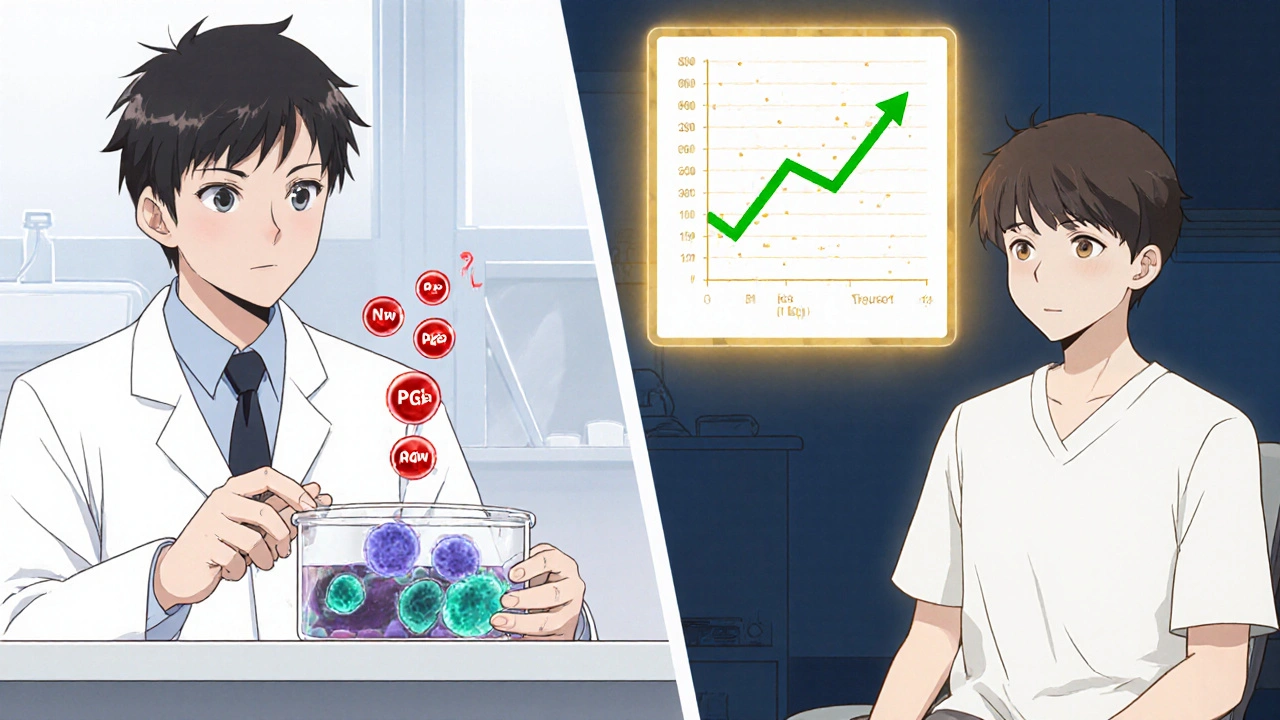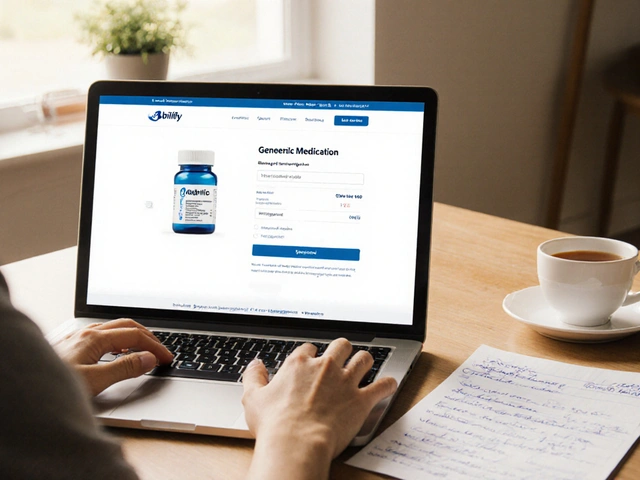When you pop a painkiller, you rarely think about what’s happening inside your immune cells. mefenamic acid is a common NSAID used for headaches, menstrual cramps, and musculoskeletal pain, but it does more than just block pain signals. It interacts with the immune system in ways that can shift inflammation, alter white‑blood‑cell activity, and even affect gut microbes. This article breaks down the science, points out potential risks, and offers practical tips for anyone taking mefenamic acid.
What is mefenamic acid?
Mefenamic Acid is a non‑steroidal anti‑inflammatory drug (NSAID) that inhibits cyclooxygenase enzymes to reduce prostaglandin synthesis. First approved in the 1960s, it is sold under brand names such as Ponstel and is often prescribed for short‑term pain relief. Its chemical formula is C₁₅H₁₅NO₂, and it is typically taken in 250 mg tablets up to three times a day.
How NSAIDs touch the immune system
All NSAIDs share a core mechanism: they block cyclooxygenase (COX) enzymes, which are key in turning arachidonic acid into prostaglandins. Prostaglandins act as messengers that tell blood vessels to dilate, pain fibers to fire, and immune cells to migrate. By dampening this pathway, NSAIDs blunt fever, pain, and swelling.
But prostaglandins also guide the immune response. Certain types, like PGE₂, suppress T‑cell activation, while others, like PGD₂, attract eosinophils. When mefenamic acid reduces these signals, the balance between pro‑ and anti‑inflammatory forces shifts.
Key immune players influenced by mefenamic acid
- Cyclooxygenase (COX‑1 and COX‑2) - enzymes that convert arachidonic acid to prostaglandins. COX‑2 is inducible during inflammation, making it the primary NSAID target.
- Prostaglandins - lipid mediators that regulate vasodilation, pain perception, and immune cell trafficking.
- Leukocytes - white‑blood cells including neutrophils, monocytes, and lymphocytes that orchestrate the body’s defense.
- Cytokines - proteins like IL‑1β, TNF‑α, and IL‑6 that amplify or temper inflammation.
- Oxidative stress - an imbalance between reactive oxygen species and antioxidant defenses, often linked to chronic inflammation.

Evidence from laboratory and clinical studies
Multiple in‑vitro experiments show that mefenamic acid reduces prostaglandin E₂ (PGE₂) production in macrophages by up to 70 % at therapeutic concentrations (10‑50 µM). This drop translates to lower expression of IL‑6 and TNF‑α, two cytokines that drive fever and joint swelling.
Human studies are more nuanced. A 2023 randomized trial with 120 patients undergoing dental extraction compared ibuprofen, naproxen, and mefenamic acid. While all three provided comparable pain relief, the mefenamic‑acid group displayed a modest rise in circulating neutrophil counts (average +8 %) 24 hours post‑procedure, suggesting a temporary rebound in innate immunity.
Long‑term epidemiological data hint at a small increase in infection risk for chronic NSAID users. A UK primary‑care cohort (2018‑2022) reported a 1.2‑fold higher odds of respiratory infections among patients prescribed mefenamic acid for more than three months, after adjusting for age, smoking, and comorbidities.
Potential risks for specific populations
Autoimmune disorders: People with rheumatoid arthritis or lupus already have dysregulated cytokine networks. Adding a COX inhibitor may further suppress beneficial prostaglandins that keep immune activation in check, potentially worsening disease flares.
Elderly patients: Age‑related immunosenescence means the elderly rely on precise inflammatory signaling for wound healing. Mefenamic acid’s blunt effect on prostaglandins can delay tissue repair and raise infection susceptibility.
Gut health: NSAIDs can irritate the gastrointestinal lining, altering the gut microbiota-a key player in systemic immunity. Small‑scale sequencing studies show a reduction in *Lactobacillus* spp. after a 7‑day course of mefenamic acid, coinciding with lower short‑chain fatty acid (SCFA) production, which is important for regulatory T‑cell development.
How mefenamic acid stacks up against other NSAIDs
| NSAID | COX selectivity | Impact on PGE₂ | Observed immune changes |
|---|---|---|---|
| Ibuprofen | Non‑selective (slight COX‑1 preference) | ~55 % reduction | Minor neutrophil rise; no significant infection increase |
| Naproxen | COX‑2 > COX‑1 | ~62 % reduction | Lower IL‑6; modest GI irritation |
| Mefenamic Acid | Balanced COX‑1/COX‑2 inhibition | ~70 % reduction | Higher neutrophil count post‑procedure; slight ↑ infection risk in long‑term use |
The table shows that mefenamic acid is a potent suppressor of prostaglandin synthesis, which explains its strong analgesic effect but also its more noticeable immune footprint.

Practical tips for safe use
- Limit duration: Aim for the shortest effective course-usually no more than 7‑10 days for acute pain.
- Mind dose: Stick to 250 mg three times a day or less, unless a physician advises otherwise.
- Watch for signs of infection: Fever, persistent cough, or unusual fatigue should prompt a medical review, especially if you’ve used mefenamic acid for weeks.
- Protect the gut: Take the medication with food or a proton‑pump inhibitor if you have a history of ulcers.
- Consider alternatives: For chronic conditions, acetaminophen or selective COX‑2 inhibitors may pose a lower immune‑modulation risk.
When to discuss with your doctor
If you fall into any of these categories, bring the conversation up at your next appointment:
- Diagnosed autoimmune disease (e.g., rheumatoid arthritis, multiple sclerosis)
- Frequent respiratory or urinary infections
- Chronic kidney or liver disease
- Age over 65 with multiple comorbidities
Your doctor can weigh the benefits of pain relief against the potential immune trade‑offs and may suggest a different analgesic or a monitoring plan.
Frequently Asked Questions
Does mefenamic acid weaken the immune system?
It doesn’t outright suppress immunity, but it alters prostaglandin pathways that influence cytokine production and white‑blood‑cell behavior. Short‑term use has minimal impact, while prolonged therapy may raise infection risk in vulnerable people.
Can I take mefenamic acid with other NSAIDs?
Combining NSAIDs increases the chance of stomach bleeding and amplifies immune modulation. It’s generally advised to avoid stacking them unless a specialist directs otherwise.
What are the signs that mefenamic acid is affecting my immunity?
Unexplained fever, persistent cough, frequent sinus infections, or delayed wound healing can be clues. If they appear while you’re on a multi‑week course, contact your healthcare provider.
Is the gut microbiome really affected by mefenamic acid?
Short‑term studies show a modest drop in beneficial *Lactobacillus* and reduced short‑chain fatty acid levels, which can influence systemic immunity. Probiotic supplementation may help, but evidence is still emerging.
Should I stop taking mefenamic acid if I have an autoimmune disease?
Not automatically. Discuss dosage and duration with your rheumatologist. Sometimes a short course for breakthrough pain is acceptable, but chronic use is usually discouraged.
Bottom line: mefenamic acid is an effective painkiller, yet its interference with prostaglandin‑driven immune pathways means you should use it wisely. Short courses, proper dosing, and awareness of personal health factors keep the benefits high and the immune drawbacks low.








Alisha Cervone
October 26, 2025 AT 18:59Mefenamic acid might mess with your gut microbes so think twice.
Diana Jones
November 9, 2025 AT 05:54When you’re juggling COX‑1 and COX‑2 inhibition, the immune cascade can feel like a badly tuned orchestra.
The article nails the fact that prostaglandin suppression isn’t just about pain but also about cytokine choreography.
If you’re looking for a quick fix, just remember that short‑term use barely nudges your white‑cells.
But for chronic sufferers, the rebound neutrophil spike is a red flag you don’t want to ignore.
Bottom line: keep the dosage minimal and pair it with food to spare your gut.
Samantha Taylor
November 22, 2025 AT 16:48The mechanistic overview presented in the article is commendably thorough, yet it glosses over several pivotal nuances that any seasoned immunopharmacologist would immediately spot.
First, the binary classification of COX selectivity fails to capture the context‑dependent isoform expression that varies between tissue types and disease states.
Second, the reduction of PGE₂ by approximately 70 % in vitro does not linearly translate to systemic cytokine dampening in vivo because compensatory pathways, such as the lipoxygenase cascade, can swiftly replenish eicosanoid signaling.
Third, the cited increase in circulating neutrophils post‑extraction might simply reflect a stress‑induced demargination rather than a true immunostimulatory effect of mefenamic acid.
Moreover, the epidemiological data linking a 1.2‑fold rise in respiratory infections to long‑term use suffers from confounding by indication, as patients with chronic pain often have comorbidities that predispose them to infection.
The article also neglects the role of microsomal prostaglandin E synthase‑1 (mPGES‑1), an enzyme that can sustain PGE₂ production despite COX inhibition, thereby preserving some inflammatory signaling.
In addition, the gut microbiome alterations described are based on a limited cohort of seven participants, which is insufficient to draw robust conclusions about dysbiosis.
A more rigorous approach would incorporate shotgun metagenomics to quantify functional shifts rather than relying on genus‑level 16S profiling.
From a pharmacokinetic perspective, the rapid absorption and short half‑life of mefenamic acid mean that peak plasma concentrations are fleeting, limiting the duration of immune modulation.
Nevertheless, the drug’s balanced COX‑1/COX‑2 inhibition profile can exacerbate gastric mucosal injury, indirectly affecting immune competence by compromising barrier integrity.
Clinicians should therefore weigh the analgesic benefits against the potential for delayed wound healing in elderly patients whose regenerative capacity is already diminished.
It is also worth noting that selective COX‑2 inhibitors, while sparing gastric mucosa, may carry their own cardiovascular risks, illustrating that no NSAID is without trade‑offs.
Patients with autoimmune diseases should be particularly vigilant, as prostaglandins also exert immunoregulatory effects that can modulate disease activity.
In practice, a short course of mefenamic acid, limited to seven days, is unlikely to produce clinically significant immunosuppression in otherwise healthy adults.
However, when therapy extends beyond this window, periodic monitoring of complete blood counts and inflammatory markers is prudent.
In summary, the article provides a solid introductory framework but would benefit from deeper exploration of compensatory eicosanoid pathways, microbiome methodology, and confounding variables in observational studies.
Joe Langner
December 6, 2025 AT 03:43Wow, that deep dive really makes my head spin – kinda awe‑inspiring and a little intimidating.
If the drug keeps the pain away, maybe it’s a small price for a calmer mind.
Still, I wonder how we can balance that with the body’s natural rhythm, especially when we’re constantly pushing meds.
It’s a fine line, and sometimes we just woudn’t notice the subtle shifts until they’re big.